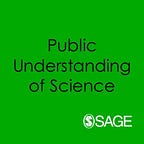Misinformation and Mass Audiences
Review by Mike Schäfer
A timely foray into the analysis of public misinformation, with a broad vista.
Misinformation has received a lot of public and scholarly attention, recently also under labels such as “alternative facts”, “fake news” or “post-truth”. This attention was triggered partly by the rise of online and social media, which enabled segments of the public to openly promote deviant viewpoints, and catalyzed by the blatant disregard of reliable information and seemingly obvious facts by populist politicians and authoritarian leaders.
Misinformation is also — and particularly — important for analyses of science communication. After all, it is science’s role in society to produce robust knowledge, and increasing numbers of scientists and science communicators try to communicate this knowledge to non-expert audiences. In many countries, however, these efforts are countered by stakeholders sowing misinformation around issues such as vaccination, global warming or evolution.
Against this backdrop, this interdisciplinary volume edited by a communication scholar, a political scientist and an information scientist is an interesting read. It employs a broad perspective on misinformation, focusing on issues such as health, smoking or environmental topics, scrutinizing misinformation advanced by politicians, corporations, think-tanks and others, and taking textual communication as well as other modalities, such as visuals or satire, into account.
The book is structured in three parts: the contributors in the first part aim to map and measure dimensions of public awareness of misinformation. Cognitive scientists Marsh & Yang identify relevant perceptual biases that foster the acceptance of misinformation. Boudewyns et al present findings on consumer awareness about health-related advertising. Cappella et al and Ahler & Sood present different measurement approaches for misinformation. Hemsley & Snyder focus on the possibility of visual misinformation in graphs and figures and assess their influence on audience misperceptions.
The volume’s second part aims to grasp the effects of misinformation for individual, organizational and societal decision-making. Green & Donahue assess the short- and long-term effects of false information in news. Young deals with the consequences of satire and irony and asks whether these genres can be seen as misinformation at all. Weeks addresses societal determinants of misinformation, such as the prevalence of ideologically oriented media and the spread of social media. Closely related, Sheble describes how the logic of social media communication can further scientific misconceptions and Maki et al describe how erroneous information may lead to environmental behaviour at odds with the recommended practice.
Finally, the third part of the book presents possible solutions. Swire & Ecker describe how several often-prescribed counter-measures fail to remedy misinformation. Similarly, Thorson provides comparative evidence regarding the (partly limited) efficacy of fact-checking in political journalism. Poulsen & Young give a historical overview of the evaluation of political fact-checking more generally. Bullock reviews the labelling practices of consumer products and asks for rules that go beyond current practice to combat fraudulent claims. Both Hemsley and Kaplan deal with the diffusion of misinformation through social networks, arguing that middle-layer gatekeepers serving as network hubs should filter or stop the flow of misinformation, and that encouraging individuals to search actively for information might serve as remedies.
The book concludes with a four-page “research agenda” from the editors, in which the omnipresence of misinformation — from political through environmental to science communication, from PR through journalism to audience research — is once again made clear. In all of these fields, the editors see the need for more research.
Overall, Misinformation and Mass Audiences is well worth reading even if two criticisms might be made. First, the volume has a certain heterogeneity, which is familiar to the avid reader of edited volumes; the individual contributions deal with different topics and differ in their approaches — partly presenting the state-of-the-art of scholarly fields (e.g. Boudewyns et al.), partly presenting own research (e.g. Marsh & Young), partly evaluating guidelines on how to counter misinformation (e.g. Swire & Ecker or Bullock) etc.
Second, the focus on “mass audiences”, which made it all the way to the book’s title, seems underdetermined and somewhat outdated. The “mass” concept is only introduced briefly in the volume’s introduction, and rarely taken up by other contributors. A more in-depth discussion of the concept, maybe in light of potential contemporary alternatives such as “masspersonal communication” (e.g. Sullivan & Carr, 2018), would have been warranted. It would also have corresponded better to the many nuanced descriptions of audiences that can be found in the book’s chapters.
For science communication scholars specifically, some of the contributions to the book — such as Hemsley & Snyder’s chapter on “visual misinformation” — will certainly be more interesting than others. Still, however, browsing the entire book will prove rewarding for science communication scholars as well. It represents a timely foray into the analysis of public misinformation, with a broad vista, providing a number of valuable insights into the phenomenon and often using examples from science communication.
Mike Schäfer is professor of science communication at the University of Zurich, Switzerland, where he also directs the Center for Higher Education and Science Studies. His recent publications include (with T. Füchslin & J. Metag) ‘The different audiences of science communication: a segmentation analysis of the Swiss population’s perceptions of science and their information and media use patternsF’, Public Understanding of Science, published online 16 January 2018.
